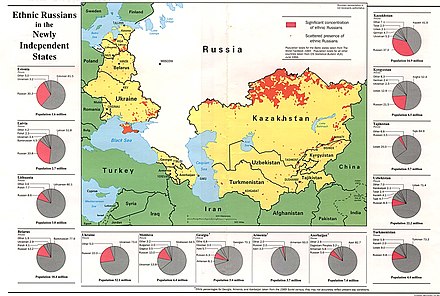Ethnic Russians in post-Soviet states
 From Wikipedia - Reading time: 5 min
From Wikipedia - Reading time: 5 min
After the dissolution of the Soviet Union (USSR) in December 1991, about 25 million ethnic Russians in post-Soviet states found themselves living outside of Russia.
All former Soviet citizens had a time window within which they could transfer their former Soviet citizenship to Russian citizenship.[citation needed] Where they did not exercise that choice, their resulting citizenship status outside Russia varied by state: from no perceivable change in status – as in Belarus – to becoming permanently resident "non-citizens" – as in Estonia and Latvia, which restricted citizenship to their pre-World War II citizens and their offspring (regardless of ethnic group) upon restoration of their independence in continuity with their sovereign identities prior to June 1940.
In June 2006 Russian President Vladimir Putin announced a plan to introduce national policy aiming at encouraging ethnic Russian immigration to Russia.[1]

| Country | Number of ethnic Russians |
Percent of national population |
As of (census data) |
|---|---|---|---|
| 8,334,141 | 17.3 | 2001[2] | |
| 2,983,317 | 14.9 | 2024[3] | |
| 720,324 | 2.1 | 2021[4] | |
| 706,992 | 7.5 | 2019[5] | |
| 437,587 | 23.4 | 2024[6] | |
| 296,268 | 21.6 | 2024[7] | |
| 274,940 | 3.8 | 2024[8] | |
| 242,000 | 5.1 | 2012[9] | |
| 144,295 | 5.0 | 2024[10] | |
| 111,726 | 4.1 | 2014[11] | |
| 71,000 | 0.7 | 2019[12] | |
| 29,000 | 0.3 | 2020[13] | |
| 26,586 | 0.7 | 2014[a] | |
| 14,074 | 0.5 | 2022[14] |
^ Does not include Abkhazia (2011 census: 22,077 Russians or 9.1% of the population) or South Ossetia (2007 estimate: 2,100 Russians or 3.0% of the population).
^ In Turkmenistan, there were estimated to be at most 150,000 ethnic Russians as of 2007, or under 2% of the population. In Uzbekistan the same year, the Russian population stood at some 800,000 people or under 4% of the country.[15]
See also
[edit]- Russians in Armenia
- Russians in Azerbaijan
- Russians in Belarus
- Russians in Estonia
- Russians in Georgia
- Russians in Kazakhstan
- Russians in Kyrgyzstan
- Russians in Latvia
- Russians in Lithuania
- Russians in Moldova
- Russians in Tajikistan
- Russians in Turkmenistan
- Russians in Ukraine
- Russians in Uzbekistan
References
[edit]- ^ Latvia: Ethnic Russians Divided On Moscow's Repatriation Scheme
- ^ "2001 | English version | Results | General results of the census | National composition of population". 2007-07-06. Archived from the original on 2007-07-06. Retrieved 2024-02-24.
- ^ https://stat.gov.kz/api/iblock/element/178068/file/en/
- ^ "Permanent population by national and / or ethnic group, urban / rural place of residence". data.egov.uz (in Russian). Retrieved 2024-02-24.
- ^ https://www.belstat.gov.by/upload/iblock/b49/b49a6306ec95b5c2d851e897490581a3.pdf [bare URL PDF]
- ^ "Population by ethnicity at the beginning of year 1935 - 2024".
- ^ "RV0222U: POPULATION BY SEX, ETHNIC NATIONALITY AND COUNTY".
- ^ "Statistical Yearbook of the Kyrgyz Republic - Statistics of the Kyrgyz Republic".
- ^ "The results of census in Turkmenistan | Chronicles of Turkmenistan". Archived from the original on 2016-10-06.
- ^ "Rodiklių duomenų bazė - Oficialiosios statistikos portalas".
- ^ "Rezultatele Recensământului Populației și al Locuințelor 2014 (RPL2014)". Rezultatele Recensământului Populației și al Locuințelor 2014 (RPL2014) (in Romanian). 2013-08-02. Retrieved 2024-02-24.
- ^ "National (ethnic) composition of population".
- ^ https://unece.org/sites/default/files/2023-09/WS10RizoevENG.pdf [bare URL PDF]
- ^ "The Main Results of RA Census 2022 / Statistical Committee of the Republic of Armenia". www.armstat.am. Retrieved 2024-02-24.
- ^ Sebastien Peyrouse, " The Russian Minority in Central Asia: Migration, Politics, and Language" Archived 2013-12-06 at the Wayback Machine, p.5. Woodrow Wilson International Center for Scholars, 2008, ISBN 193-35493-27
 KSF
KSF